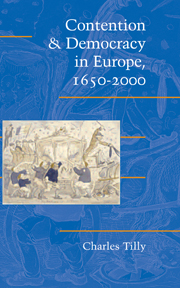3 - UNDEMOCRATIC CONTENTION IN EUROPE, 1650–1850
Published online by Cambridge University Press: 29 May 2010
Summary
From the perspective of contentious politics, Europe had more than one Old Regime. According to the arguments just unfolded, Europe's undemocratic regimes should have displayed systematically different sorts of contention. Different combinations of coercion, capital, and commitment should have affected the trajectories of various governments within the limits set by an idealized strong state (expanding capacity with little or no increase in protected consultation) and an idealized weak state (expanding consultation with little or no increase in capacity). Changes in capacity and/or consultation, in their turn, should have altered the character of contention. Finally, contention itself should have affected the character of regimes, even short of conquest, colonization, or revolution. Let us try out these expectations on the contrasting histories of the Low Countries and Iberia between 1650 and 1850. The Low Countries and Iberia created very different regimes after 1650, and experienced contrasting forms of contentious politics. Do the histories of the Low Countries and Iberia confirm our expectations? At least roughly, they do.
As of 1650, the 1648 treaties of Westphalia had finally confirmed outcomes of the momentous 17th-century Dutch revolt against Spain. The treaties provided de jure certification for the Low Countries' longstanding de facto division into the autonomous United Provinces in the north, a Habsburg-controlled Spanish Netherlands in the south, plus imperially connected but semi-autonomous Luxembourg and several city-states, likewise to the south. At midcentury, Holland was arguably Europe's predominant economic power (Davids 1995; Kindleberger 1996: 100–103; de Vries and van der Woude 1997: 665–80).
- Type
- Chapter
- Information
- Contention and Democracy in Europe, 1650–2000 , pp. 70 - 94Publisher: Cambridge University PressPrint publication year: 2003

